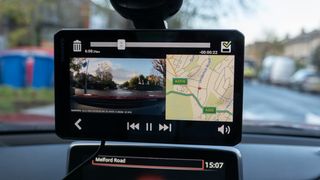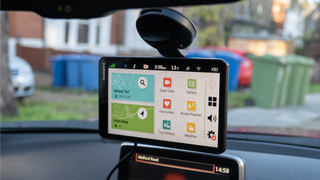Two-minute review
You’d be forgiven for thinking that dedicated sat navs were a thing of the past, usurped first by integrated systems from car manufacturers, then by smartphones. This may be true for many drivers, but for those who want a navigation system that promises to outshine both car and phone, a dedicated unit can still be the way to go. Especially if you are a habitual road-tripper keen for international adventure, and would rather keep your smartphone hidden safely away from the windshield.
The Garmin DriveCam 76 fits this bill, but also throws in a dash cam. Like the best dash cams, it quietly records the view ahead on every journey, then securely saves footage if a collision is detected or the manual record icon is tapped.
It’s an extension of Garmin’s DriveSmart family of navigation systems, only with a Full HD dash cam attached to the rear of its 7-inch touchscreen display. This addition bumps the price up from $299.99 / £229.99 for the similarly sized DriveSmart 76, to a considerable $449.99 / £419.99 for the DriveCam 76.
The resolution of the TFT panel is 1024 x 600. While that pixel count doesn’t sound too impressive compared to a modern smartphone or tablet of a similar size, it’s absolutely fine for a sat nav. The interface is bright, clear and intuitive, with large icons that are easy to read and tap while on the move. Brightness isn’t adjusted automatically, which is a shame, but it only takes a couple of taps and a swipe to dim the screen so it doesn’t dazzle in the dark.
The DriveCam 76 fits to your windscreen with a suction cup. This clips securely into place with a clamp, and fits to the back of the sat-nav with a ball-and-socket joint that allows for adjustment in every direction. The dash cam lens also adjusts horizontally, and between these two movements you’ll find a position that points the display towards the driver and the camera directly at the road ahead.
Power comes via a USB-C port and an included 12V lighter socket adapter. There’s 32GB of internal storage, plus a microSD card slot for storing up to 256GB of dash cam recordings; a card is not included in the box. Battery life is a claimed 30 minutes, but in reality this is a device you’ll want to always have plugged in, unless you’re on the shortest of journeys.
Given the large size of this product compared to a regular dash cam, you’ll have to think carefully about placement to avoid blocking your view. Cars with shallow windscreens and integrated displays that stick up from dashboard leave very little space for the DriveCam 76. This review was conducted using a Mazda MX-5, and there really wasn’t enough space to fit the Garmin. Sat between the car’s central mirror and its own display, too much of the windshield was blocked for our liking. Naturally, a larger vehicle, or one with a display positioned differently (or without one at all) should be just fine.
That’s really the point here: the DriveCam 76 is a great addition to older vehicles that lack their own infotainment and navigation systems. As well as mapping and dash cam functionality, the Garmin can show a local weather forecast, in addition to incoming notifications from your smartphone – although you’ll want to switch off everything apart from calls and messages in the system to avoid being notified for absolutely everything. There are also speed camera alerts, plus lane drift and forward collision warnings.
Garmin made a name for itself with excellent mapping systems, and this is where the DriveCam 76 shines brightest. Addresses are easy to input and instructions are loud, clear and well-timed. You can also speak locations to the voice recognition system, summoned by saying ‘Hey Garmin’. Being told street names and landmarks with directions really helps when navigating an unfamiliar area, and the interface switches to a split-screen with graphics to help you take the correct lane at roundabouts and junctions.
Moving to Garmin navigation from Google Maps or Apple Maps takes a bit of acclimatisation. Once you’re tuned into how its instructions are delivered – and what its visual prompts look like – you’ll have no issues at all. It’s arguably a better navigation experience than a smartphone, and only takes some getting used to in the same way as switching from one navigation app to another does.
Live traffic data comes from your phone’s data connection. This is set up by downloading Garmin’s smartphone app and connecting to the DriveCam 76 via Bluetooth. This connection is established automatically after the initial setup. The device also has Wi-Fi, which can connect to your home router for downloading software updates and new mapping databases.
Integrated data from FourSquare and TripAdvisor helps you find places by stating their name instead of their address, but we found this didn’t always work perfectly, with the DriveCam occasionally suggesting an incorrect destination. Some buildings are rendered in 3D to further help with navigation and, when connected to your smartphone’s data connection, live fuel prices are shown at stations along your route. Pair with your phone, and you can also make and receive calls, either by tapping the DriveCam or issuing a voice command.
The built-in dash cam captures footage in Full HD at 30 frames per second. By default, the DriveCam 76 overlays the current time, date and vehicle speed. With HDR and a resolution of 1920 x 1080, video quality is fairly good. Details like road signs and number plates are legible, while exposure is balanced.
Given the DriveCam 76 is partly a dash cam with a massive screen, we liked how it is easy to view recordings (along with a map to show where they took place) on the device itself, rather than having to transfer everything to a phone or computer.
The 140-degree lens is wide enough, but falls short of the 180 degrees of the Garmin Dash Cam 67W. Also counting against the DriveCam is how footage wobbles and distorts, likely due to the stabilisation software trying to iron out bumps in the road. This doesn’t take any detail away, but means footage is worse than from some other Garmin dash cams. This made the dash cam feel like an afterthought, rather than a key feature of what is an expensive and otherwise premium-feeling product.




